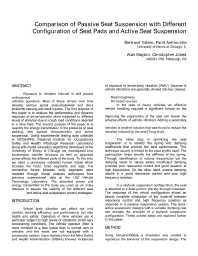Mining Publication: Comparison of Passive Seat Suspension with Different Configuration of Seat Pads and Active Seat Suspension
Original creation date: April 2008
Exposure to vibration induced in and around underground mine’s exploration is a major concern to vehicles operators. Most of these drivers over time develop serious spinal musculoskeletal and discs problems causing low back injuries. The first purpose of this paper is to analyze the performance and dynamic response of driver/operator when subjected to different levels of vibration due to rough road conditions depicted in a mine field. The second purpose of the paper is to quantify the energy transmission in the presence of seat padding with special characteristics and active suspension. Using experimental testing data collected at NIOSH/PRL (National Institute for Occupational Safety and Health/ Pittsburgh Research Laboratory) along with model simulation algorithms developed at the University of Illinois at Chicago we investigated how acceleration transfer functions as well as absorbed power affects the different parts of the body. To this end, we used a previously validated human model which includes the head, torso segments and legs. The connective forces between body segments were modeled through modal analysis techniques from previous experimental data at the UIC Vehicle Technology Laboratory. The absorbed power and energy transmitted to the body are used as an index measure to assess the viability of the different seat padding’s and active seat suspension control strategies.
Authors: B Valero, F Amirouche, AG Mayton, C Jobes
Conference Paper - April 2008
NIOSHTIC2 Number: 20033653
Human Factors in Seating Comfort and Driving and Automotive Telematics and Advances in Instrument Panels and Interiors. Warrendale, PA: Society of Automotive Engineers, Inc., technical paper 2007-01-0350, 2007 Apr; :1-5
See Also
- Back Injury Control Measures for Manual Lifting and Seat Design
- Development and Application of Reservoir Models and Artificial Neural Networks for Optimizing Ventilation Air Requirements in Development Mining of Coal Seams
- Improved Seat Reduces Jarring/Jolting for Operators of Low-Coal Shuttle Cars
- Laboratory Investigation of Seat Suspension Design Performance during Vibration Testing
- Modeling and Prediction of Ventilation Methane Emissions of U.S. Longwall Mines Using Supervised Artificial Neural Networks
- Modernization and Further Development of the NIOSH Mine Emergency Response Training System (MERITS), Phase 1
- Physiological Responses and Subjective Discomfort of Simulated Whole-Body Vibration From a Mobile Underground Mining Machine
- SPONCOM - A Computer Program for the Prediction of the Spontaneous Combustion Potential of an Underground Coal Mine
- Technology News 545 - NIOSH Updates Spontaneous Combustion Assessment Software
- Technology News 549 - MFIRE 3.0 - NIOSH Brings MFIRE into 21st Century
- Page last reviewed: 9/21/2012
- Page last updated: 9/21/2012
- Content source: National Institute for Occupational Safety and Health, Mining Program


 ShareCompartir
ShareCompartir
